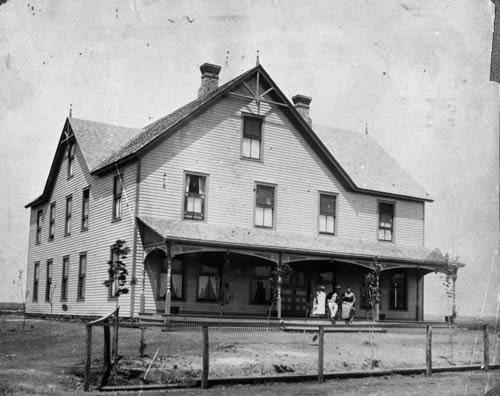We left NW Oklahoma on Wed. 24 July. After our last trip, I was surprised, or shocked, after completing the financial tally, to learn that we had spent $108 in highway tolls. Since I dare to only go so fast with an RV in tow anyhow, I viewed that pretty much as a waste. With the price of gas, I decided the gas tank was a much better place to put that money. Besides, getting off the ribbon of concrete had to expose us to some more interesting sights and experiences. This time I vowed to not spend a penny on tolls unless confronted with the only bridge that crossed a river. The no-toll route to Wisconsin would require much greater attention to the map, but off across the flat plains we went.
Ned Turnly
Photo credit: google images
Ned Turnly’s recruiting efforts were successful. In 1888, he arrived from England with a number of new recruits, and in a short while the members had increased to around a hundred from England, Ireland, and Scotland. The pace at which the village grew out of the Kansas dirt was amazing. They quickly built a general store and post office for the town of Runnymede and began selling groceries and dry goods. They then added a creamery, and a livery stable to care for the horses, followed by restaurants, a soda-pop factory, lumber yard, an Episcopal church, and a stagecoach line. While building businesses, they also needed to build homes, and by 1890, after a mere two years, there stood a typical English village with curved driveways leading to English-style houses set among rows of neatly clipped privet hedges. Around the village were polo grounds, a steeplechase course, race track, bowling alley, billiard parlor, tennis courts, and a football field, and they even challenged a team from Wichita to play them in English football, or rugby. Just as these young men had gone on fox hunts in Britain, they now sported red hunting coats and followed hounds across the buffalo-grass prairie in pursuit of coyotes. Farms and orchards were built on the model of English estates. Feeling themselves in the heart of the Wild West they had heard so much about, you wouldn’t see them about without a selection of guns and knives hanging from their sides.
The Runnymede Arms Hotel
Photo credit: Kansas Historical Society
The Runnymede Church today in Harper, KS.
The showplace of the town was undoubtedly the three-story Runnymede Arms, a hotel completed in only three months in 1889, and appointed with every amenity of the day for guests. In May, 1890, the hotel was saved only by great effort when the adjacent livery stables burned. The hotel got away with burned paint, but a noted citizen and promoter of the town died in the stable fire. The death and fire was just the first in a series of events that reversed the town’s fortunes as quickly as they had flourished. The fatal fire alarmed the wealthy families back in Britain, the families were also tiring of the constant financial drain of supporting their young men in America, European investments were falling off, and the region was feeling an economic downturn. The young men were getting bored with the prairie life, began to realize that they were never going to become ranchers and wanted to go home. The final blow was when the railroad ran its tracks southwest of town. Railroads at the time were building and killing towns by where they put their tracks. Railroad men were given free homes, free land, and other “incentives” (more appropriately called bribes) to encourage them to place tracks and stations where they would benefit the commerce of a community. Turnly knew the town could not survive without a rail line, and Runnymede’s demise was quick when it drew the economic short straw. In July, 1892, Ned Turnly’s real estate holdings were lost for non-payment of taxes.
The Runnymede today in Alva, OK.
Photo credit: google images



No comments:
Post a Comment